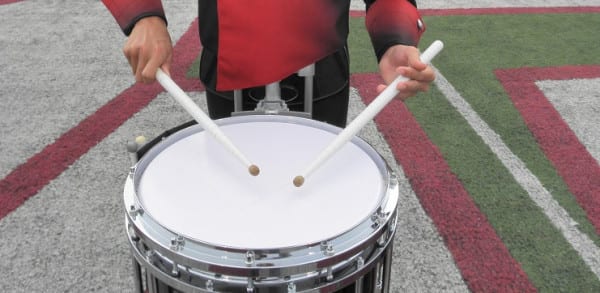An Off Season Guide to Care & Maintenance of your Percussion Instruments
Feb 08, 2016

If you sometimes feel tired after a long practice session, imagine the wear and tear on them, since they are taking a literal pounding by all types of sticks and mallets. Being proactive about protecting your investment does not cost a lot, but the returns are huge, since your marching percussion gear will not only sound better but also last longer.
Though it may take time to do a thorough job maintaining your marching percussion and pit percussion instruments, think about all the money your program will save. The good news is that despite all of the stress and strain a long season takes on your gear, there are several things you can do to keep your equipment in top competitive shape all year round.
To institute an effective and efficient routine and practice, each ensemble should designate a specific individual to be responsible for completing an end-of-season inventory and maintenance check of all instruments during the off-season. It’s also a good idea to have each member of the organization check his or her particular piece of gear after every show or practice to prepare for the next event and ensure that long-term maintenance is made easier.
When it comes to maintaining marching percussion instruments, there are several over-arching principles to keep in mind. Do not keep the gear on an equipment truck for any length of time. All instruments – including keyboards – should be kept under some form of supervised or secure arrangement to avoid theft. Seasonal weather conditions in the winter and summer, especially in the Midwest and Eastern part of the United States, can significantly damage percussion instruments. The last thing you want is for that truck to leak water on the instruments.
As a general rule, it is best to store all musical instruments in a cool, dry environment year-round. Any environment with extreme temperature changes creates unnecessary wear and tear. At the end of every season the entire battery should be thoroughly cleaned. We recommend taking the heads off each drum, cleaning each part, and re-lubricating everything with lithium grease as the drum is reassembled. To ensure optimal storage conditions, clean drum covers should be placed on the drums, which should then be stored in soft or (preferably) hard cases.
Care details on battery instruments are provided below. For all drums, hardware and percussion instruments, wipe the parts down with a soft cloth without using any chemicals, which can damage finishes and do more harm than good.
Marching Battery Care & Maintenance
Snare Drums
- Each drum should be carefully inspected and cleaned while being disassembled and then reassembled.
- Wipe down each drum with a soft cloth including the hardware and the shell.
- The tension on both the top head and bottom head should be reduced by half. The heads should be taught to keep the tension rods in place during storage.
- Snare guts - The vertical adjustment should be loosened by three or four turns.
- If the drums have the MTS unit, the MTS should be stored in the off or down position.
- Ensure that all of the hardware attached to the drum for the carrier is tight and in working order.
- Take note of any missing or corroded parts that may need replacement.
- Place a clean drum cover back on the drum and the place the drum in a hard or soft case.
- Each drum should be stored in a secure and cool environment.
Multi-Toms
- Each tom set should be carefully inspected and cleaned while being disassembled and then reassembled.
- Wipe down each drum with a soft cloth including the hardware and the shell.
- The tension on the head should be reduced by half. The heads should be taught to keep the tension rods in place during storage.
- Make sure all of the spacers and tenor rails are tight and in working order.
- Take note of any missing or corroded parts that may need replacement.
- Place a clean drum cover back on the drum and the place the drum in a hard or soft case.
- Each drum should be stored in a secure and cool environment.
Bass Drums
- Each drum should be carefully inspected and cleaned while being disassembled and then reassembled.
- Wipe down each drum with a soft cloth including the hardware and the shell
- The tension on both heads should be reduced by half. The heads should be taught to keep the tension rods in place during storage.
- Take note of any missing or corroded parts that may need replacement.
- Place a clean drum cover back on the drum and the place the drum in a hard or soft case.
- Each drum should be stored in a secure and cool environment.
Hardware and Carriers
- Wipe down all parts with a soft cloth.
- These items can be left stacked neatly in an indoor facility.
- Take note of any missing or corroded parts for replacement for replacement prior to the first camp.
- Do not store hardware or carriers in the cases with the drums. This can damage the finish and the hardware.
Pit Percussion Care & Maintenance
Yamaha does not recommend keeping keyboard instruments on an equipment truck and reserves the right to refuse warranty replacements of any instrument that is not properly stored during the off season. These instruments should be kept under some form of supervision or security at all times to ensure the integrity of the instrument. The best environment for a keyboard instruments is to have the entire instrument stored indoors in a cool dry place to avoid the extreme heat or cold experienced when stored on the equipment truck. Improper winter storage will do significant damage to percussion instruments.
Marimbas, Vibes and Xylophones
- Wipe down the bars with a soft cloth. Avoid using any chemical to clean the bars.
- Take the bars off the instrument and store in a cool dry place off the floor. The bars should be wrapped in a soft blanket and can be rolled up like a sleeping bag. Bar bags are available and highly recommended. These bags are made specifically for the bars and will help to prevent any sliding or shifting that is often found with blankets and sleeping bags.
- Avoid storing any objects on the wood frames or the accessory bars.
- Wipe down the wood and metal frame with a soft cloth.
- Take note of any missing or corroded parts that may need replacement.
- Check all cord and replace any that is worn or frayed.
- Place a clean cover on the instrument for storage.
Timpani
- Wipe down the bowls and heads with a soft cloth. Avoid the use of any chemical.
- The heads should be left in-tune. Do not adjust the tension of the heads.
- Pedals should be in the forward or “toe down” position to keep the tension on the heads.
- Take note of any missing or corroded parts that may need replacement.
- Place a clean cover on the instrument for storage.
Bells
- Wipe down the bars with a soft cloth. Avoid using any chemical to clean the bars.
- The bars do not have to be removed from the instrument frame.
- Store the instrument in its original, closed case. Do not store the instrument lying flat on top of another mallet instrument such as a xylophone, marimba or vibraphone.
- The instrument should be stored flat in a cool dry room.
Chimes
- Wipe down the tubes and heads with a soft cloth. Avoid the use of any chemical.
- Take note of any missing or corroded parts that may need replacement.
- Check all cord and replace any that is worn or frayed
- The instrument should be stored upright in a cool dry room. Place a clean cover on the instrument for storage.
Concert Snare and Concert Toms
- Wipe down each drum with a soft cloth including the hardware and the shell. Avoid the use of any chemical.
- The tension on the drum heads should be reduced by half. The drum head should be taught to keep the tension rods in place during storage.
- For the snare guts, the vertical adjustment should be loosened by three or four turns and in the off position.
- It is strongly recommended that snares be stored in a case. The toms should be stored in hard cases if appropriate sizes are available. Yamaha recommends drum set cases for any drum set.
Concert Bass
- Wipe down each drum with a soft cloth, hardware and the shell. Avoid the use of any chemical.
- The drum head should remain in-tune and does not have to be loosened.
- Place a clean cover on the instrument for storage.
Miscellaneous Hardware
- All hardware should be cleaned with a soft cloth.
- Stack the hardware neatly in an indoor environment.
- Tighten all parts before storing.
- Take note of any missing or corroded parts that may need replacement.
- Hardware tends to disappear during the off season because the parts and pieces are small. A full inventory list of all equipment is in order to help cut down on future purchase needs.
Pro-Audio Equipment Care & Maintenance
The optimal situation for Pro-Audio equipment is to have it all stored indoors in a cool dry place. This will help avoid the extreme heat or cold experienced when stored on the equipment truck. This is a must due to the nature of the product. Yamaha will not warranty any pro audio equipment that is not stored under these guidelines.
General Cleaning
- First, ensure that all pro-audio equipment is turned off and unplugged prior to any cleaning.
- Second, all of the equipment needs a good cleaning. If the ensemble has carpeted loudspeakers, they can be vacuumed off gently. All the other equipment should be wiped down with a soft cloth. If a spray cleaner is needed, spray the cloth then wipe down the equipment to avoid getting the equipment wet. This is especially important for the mixer.
- If there are any parts of the PA system that were damaged or broken, this needs to be addressed now so that the ensemble will be ready for next season. Get it in for service while there is down time.
Loudspeakers
The loudspeakers have the hardest jobs of the PA equipment. Inspect them carefully and look for tears and cracking of the speaker cones and listen carefully for buzzes and other noises that indicate something inside the speaker might be loose. (Use a CD player and your favorite music!) Use a couple of different kinds of music to hear the high and low ends of the timbre spectrum to ensure the speaker is working properly.
Microphones and Stands
Microphones and electronic equipment are highly susceptible to damage from moisture and wide temperature variations, both of which are common in the equipment truck. Store the gear in a cool dry space. If the ensemble has any wireless microphones, pull the batteries out of the transmitters and throw them out. You will be getting fresh batteries next season.
Cables
All of the cabling needs to be cleaned and coiled neatly. This will help avoid kinks and knots that are the wire’s worst enemy. Professional sound companies do this all the time. Any connectors or plugs that show signs of damage or breakage need to be replaced. Your ensemble cannot afford to have one of these little things ruining your performance. Cables are expendable as they are constantly being drug along the ground and will damage easily.
Wheels
Go to the local motorcycle shop and get some PJ1 black chain lube (www.pj1.com) to lubricate all the casters on your cases and carts. This stuff is helpful because it goes on really thin like penetrating oil to get in and lubricate, but turns to heavier grease that stays put and will not wind up all over the truck or on your uniform. This is also recommended for the Multi-Frame and Tough-Terrain frame casters.
Source: Yamaha Corporation of America

